Assessment Workbook: FNSACC503 Manage budgets and forecasts
VerifiedAdded on 2023/06/03
|15
|4250
|387
AI Summary
This assessment workbook is for FNSACC503 Manage budgets and forecasts. It includes short answer questions, a cash receipts forecast, break even analysis, and strategies to mitigate financial risks. Learn how to prepare a budget, conduct discussions with stakeholders, and establish correct assumptions and parameters.
Contribute Materials
Your contribution can guide someone’s learning journey. Share your
documents today.
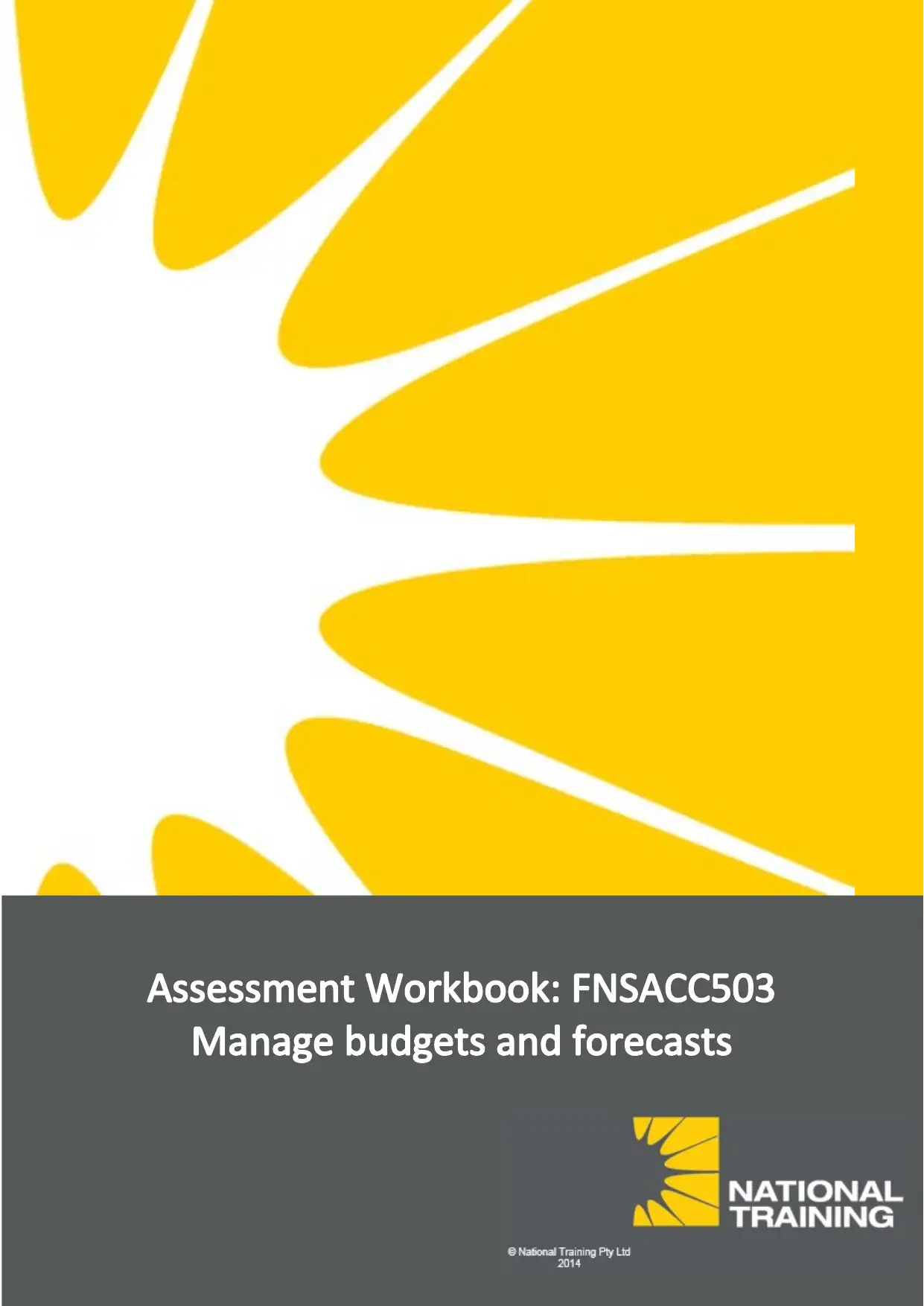
Assessment Workbook – FNSACC503 1 | P a g e Version 4.0
Assessment Workbook: FNSACC503
Manage budgets and forecasts
Assessment Workbook: FNSACC503
Manage budgets and forecasts
Secure Best Marks with AI Grader
Need help grading? Try our AI Grader for instant feedback on your assignments.
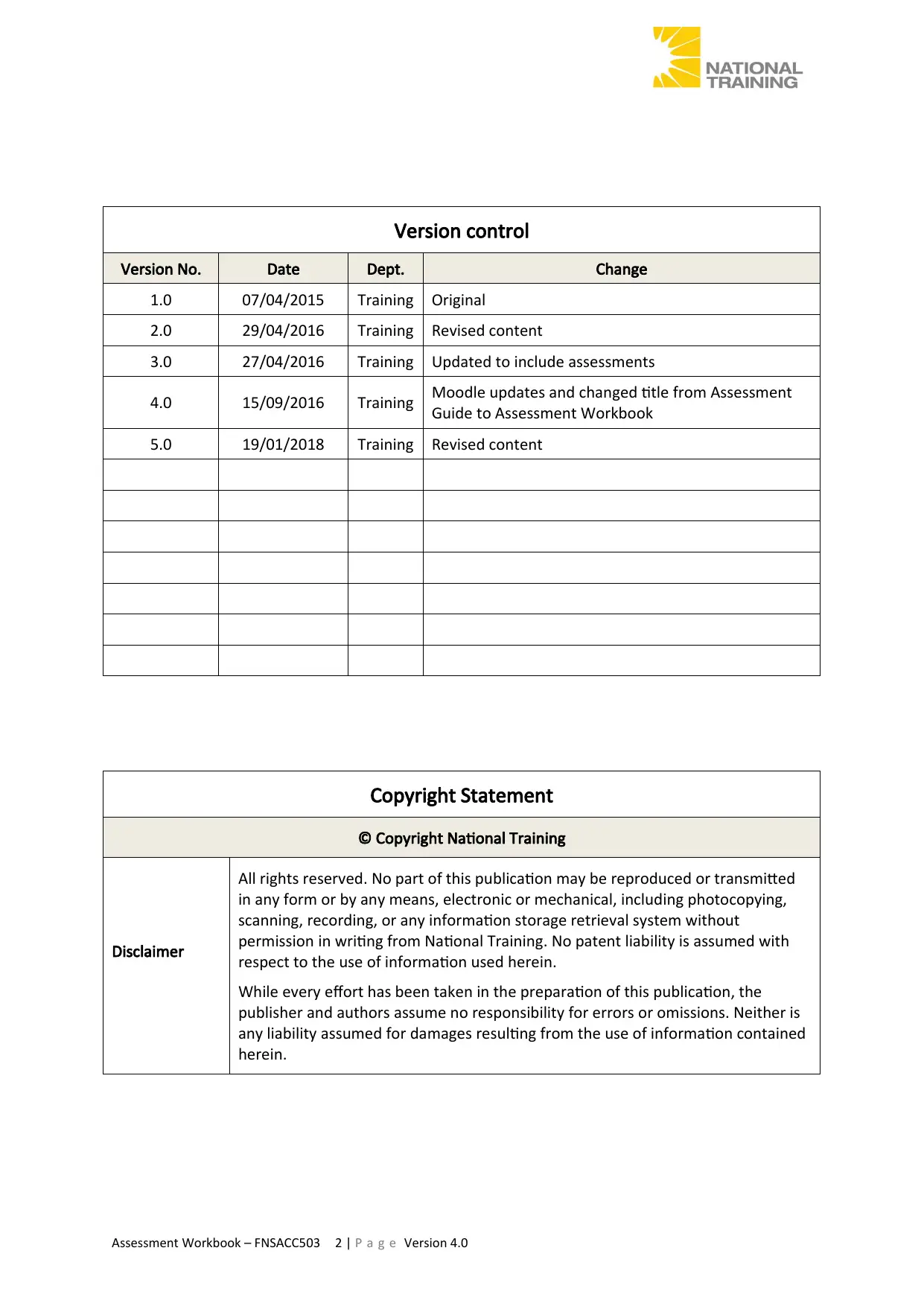
Version control
Version No. Date Dept. Change
1.0 07/04/2015 Training Original
2.0 29/04/2016 Training Revised content
3.0 27/04/2016 Training Updated to include assessments
4.0 15/09/2016 Training Moodle updates and changed title from Assessment
Guide to Assessment Workbook
5.0 19/01/2018 Training Revised content
Copyright Statement
© Copyright National Training
Disclaimer
All rights reserved. No part of this publication may be reproduced or transmitted
in any form or by any means, electronic or mechanical, including photocopying,
scanning, recording, or any information storage retrieval system without
permission in writing from National Training. No patent liability is assumed with
respect to the use of information used herein.
While every effort has been taken in the preparation of this publication, the
publisher and authors assume no responsibility for errors or omissions. Neither is
any liability assumed for damages resulting from the use of information contained
herein.
Assessment Workbook – FNSACC503 2 | P a g e Version 4.0
Version No. Date Dept. Change
1.0 07/04/2015 Training Original
2.0 29/04/2016 Training Revised content
3.0 27/04/2016 Training Updated to include assessments
4.0 15/09/2016 Training Moodle updates and changed title from Assessment
Guide to Assessment Workbook
5.0 19/01/2018 Training Revised content
Copyright Statement
© Copyright National Training
Disclaimer
All rights reserved. No part of this publication may be reproduced or transmitted
in any form or by any means, electronic or mechanical, including photocopying,
scanning, recording, or any information storage retrieval system without
permission in writing from National Training. No patent liability is assumed with
respect to the use of information used herein.
While every effort has been taken in the preparation of this publication, the
publisher and authors assume no responsibility for errors or omissions. Neither is
any liability assumed for damages resulting from the use of information contained
herein.
Assessment Workbook – FNSACC503 2 | P a g e Version 4.0
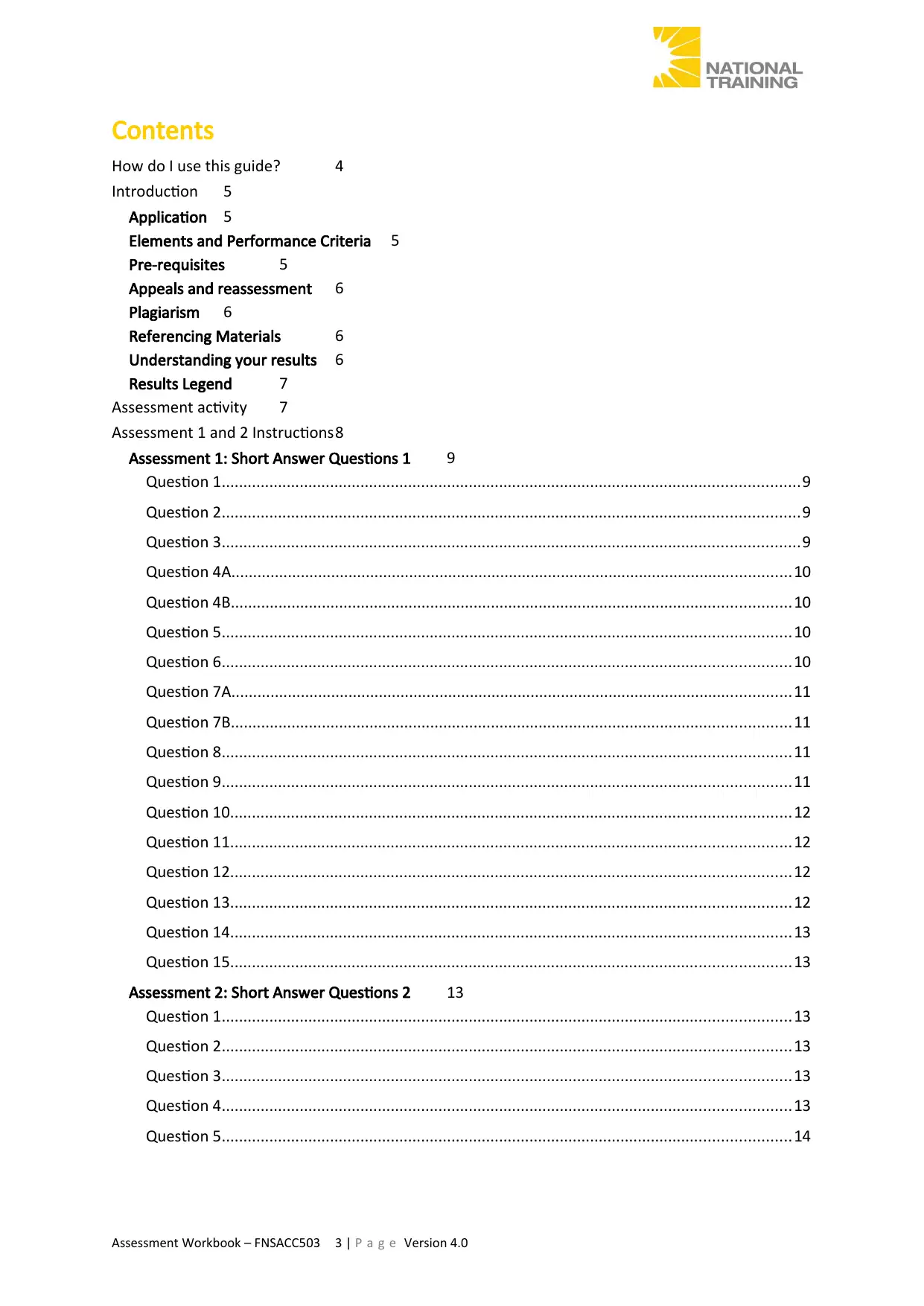
Contents
How do I use this guide? 4
Introduction 5
Application 5
Elements and Performance Criteria 5
Pre-requisites 5
Appeals and reassessment 6
Plagiarism 6
Referencing Materials 6
Understanding your results 6
Results Legend 7
Assessment activity 7
Assessment 1 and 2 Instructions8
Assessment 1: Short Answer Questions 1 9
Question 1.....................................................................................................................................9
Question 2.....................................................................................................................................9
Question 3.....................................................................................................................................9
Question 4A.................................................................................................................................10
Question 4B.................................................................................................................................10
Question 5...................................................................................................................................10
Question 6...................................................................................................................................10
Question 7A.................................................................................................................................11
Question 7B.................................................................................................................................11
Question 8...................................................................................................................................11
Question 9...................................................................................................................................11
Question 10.................................................................................................................................12
Question 11.................................................................................................................................12
Question 12.................................................................................................................................12
Question 13.................................................................................................................................12
Question 14.................................................................................................................................13
Question 15.................................................................................................................................13
Assessment 2: Short Answer Questions 2 13
Question 1...................................................................................................................................13
Question 2...................................................................................................................................13
Question 3...................................................................................................................................13
Question 4...................................................................................................................................13
Question 5...................................................................................................................................14
Assessment Workbook – FNSACC503 3 | P a g e Version 4.0
How do I use this guide? 4
Introduction 5
Application 5
Elements and Performance Criteria 5
Pre-requisites 5
Appeals and reassessment 6
Plagiarism 6
Referencing Materials 6
Understanding your results 6
Results Legend 7
Assessment activity 7
Assessment 1 and 2 Instructions8
Assessment 1: Short Answer Questions 1 9
Question 1.....................................................................................................................................9
Question 2.....................................................................................................................................9
Question 3.....................................................................................................................................9
Question 4A.................................................................................................................................10
Question 4B.................................................................................................................................10
Question 5...................................................................................................................................10
Question 6...................................................................................................................................10
Question 7A.................................................................................................................................11
Question 7B.................................................................................................................................11
Question 8...................................................................................................................................11
Question 9...................................................................................................................................11
Question 10.................................................................................................................................12
Question 11.................................................................................................................................12
Question 12.................................................................................................................................12
Question 13.................................................................................................................................12
Question 14.................................................................................................................................13
Question 15.................................................................................................................................13
Assessment 2: Short Answer Questions 2 13
Question 1...................................................................................................................................13
Question 2...................................................................................................................................13
Question 3...................................................................................................................................13
Question 4...................................................................................................................................13
Question 5...................................................................................................................................14
Assessment Workbook – FNSACC503 3 | P a g e Version 4.0
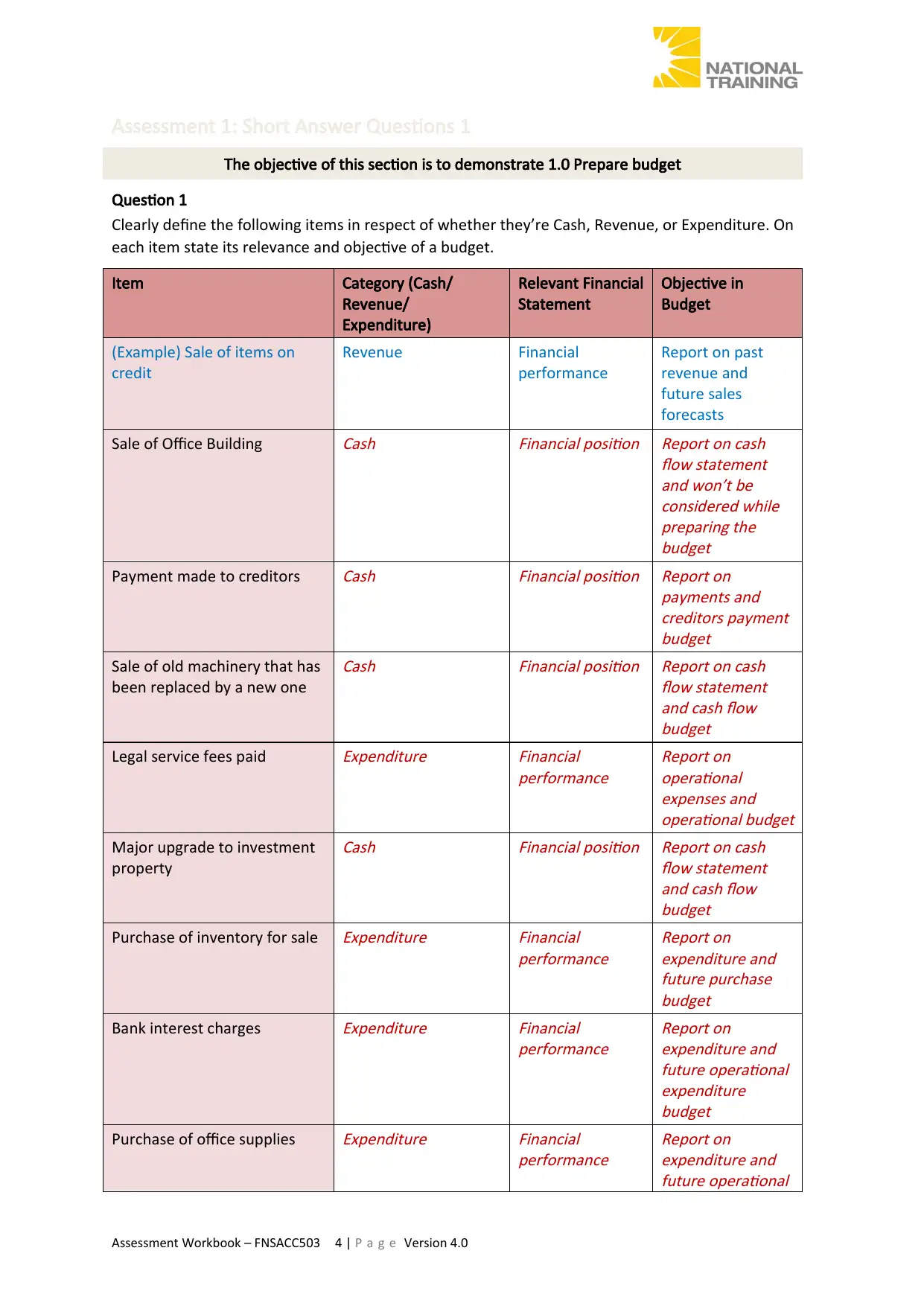
Assessment 1: Short Answer Questions 1
The objective of this section is to demonstrate 1.0 Prepare budget
Question 1
Clearly define the following items in respect of whether they’re Cash, Revenue, or Expenditure. On
each item state its relevance and objective of a budget.
Item Category (Cash/
Revenue/
Expenditure)
Relevant Financial
Statement
Objective in
Budget
(Example) Sale of items on
credit
Revenue Financial
performance
Report on past
revenue and
future sales
forecasts
Sale of Office Building
Cash
Financial position Report on cash
flow statement
and won’t be
considered while
preparing the
budget
Payment made to creditors
Cash
Financial position Report on
payments and
creditors payment
budget
Sale of old machinery that has
been replaced by a new one
Cash
Financial position Report on cash
flow statement
and cash flow
budget
Legal service fees paid
Expenditure
Financial
performance
Report on
operational
expenses and
operational budget
Major upgrade to investment
property
Cash
Financial position Report on cash
flow statement
and cash flow
budget
Purchase of inventory for sale
Expenditure
Financial
performance
Report on
expenditure and
future purchase
budget
Bank interest charges
Expenditure
Financial
performance
Report on
expenditure and
future operational
expenditure
budget
Purchase of office supplies
Expenditure
Financial
performance
Report on
expenditure and
future operational
Assessment Workbook – FNSACC503 4 | P a g e Version 4.0
The objective of this section is to demonstrate 1.0 Prepare budget
Question 1
Clearly define the following items in respect of whether they’re Cash, Revenue, or Expenditure. On
each item state its relevance and objective of a budget.
Item Category (Cash/
Revenue/
Expenditure)
Relevant Financial
Statement
Objective in
Budget
(Example) Sale of items on
credit
Revenue Financial
performance
Report on past
revenue and
future sales
forecasts
Sale of Office Building
Cash
Financial position Report on cash
flow statement
and won’t be
considered while
preparing the
budget
Payment made to creditors
Cash
Financial position Report on
payments and
creditors payment
budget
Sale of old machinery that has
been replaced by a new one
Cash
Financial position Report on cash
flow statement
and cash flow
budget
Legal service fees paid
Expenditure
Financial
performance
Report on
operational
expenses and
operational budget
Major upgrade to investment
property
Cash
Financial position Report on cash
flow statement
and cash flow
budget
Purchase of inventory for sale
Expenditure
Financial
performance
Report on
expenditure and
future purchase
budget
Bank interest charges
Expenditure
Financial
performance
Report on
expenditure and
future operational
expenditure
budget
Purchase of office supplies
Expenditure
Financial
performance
Report on
expenditure and
future operational
Assessment Workbook – FNSACC503 4 | P a g e Version 4.0
Secure Best Marks with AI Grader
Need help grading? Try our AI Grader for instant feedback on your assignments.
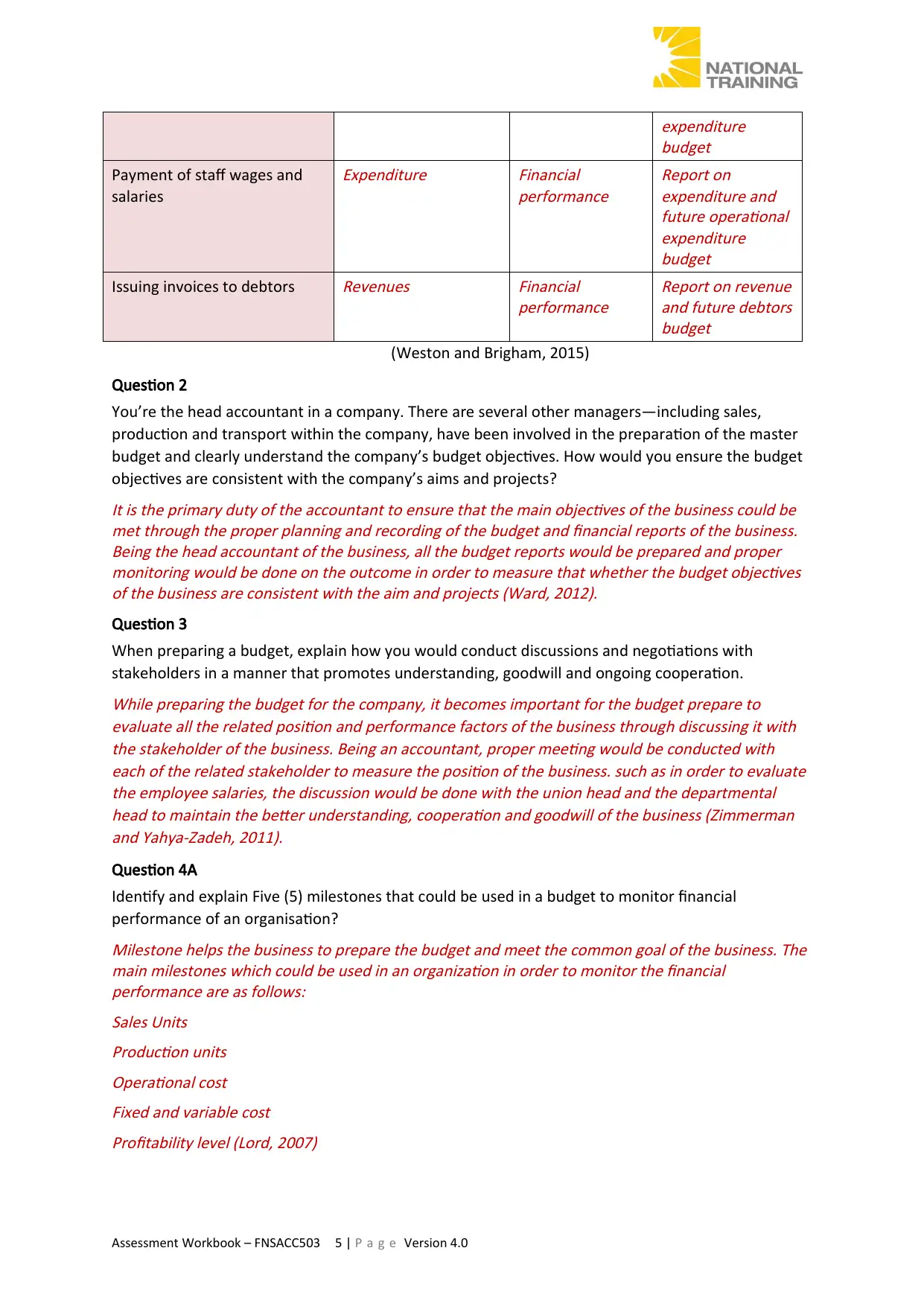
expenditure
budget
Payment of staff wages and
salaries
Expenditure
Financial
performance
Report on
expenditure and
future operational
expenditure
budget
Issuing invoices to debtors
Revenues
Financial
performance
Report on revenue
and future debtors
budget
(Weston and Brigham, 2015)
Question 2
You’re the head accountant in a company. There are several other managers—including sales,
production and transport within the company, have been involved in the preparation of the master
budget and clearly understand the company’s budget objectives. How would you ensure the budget
objectives are consistent with the company’s aims and projects?It is the primary duty of the accountant to ensure that the main objectives of the business could be
met through the proper planning and recording of the budget and financial reports of the business.
Being the head accountant of the business, all the budget reports would be prepared and proper
monitoring would be done on the outcome in order to measure that whether the budget objectives
of the business are consistent with the aim and projects (Ward, 2012).
Question 3
When preparing a budget, explain how you would conduct discussions and negotiations with
stakeholders in a manner that promotes understanding, goodwill and ongoing cooperation.While preparing the budget for the company, it becomes important for the budget prepare to
evaluate all the related position and performance factors of the business through discussing it with
the stakeholder of the business. Being an accountant, proper meeting would be conducted with
each of the related stakeholder to measure the position of the business. such as in order to evaluate
the employee salaries, the discussion would be done with the union head and the departmental
head to maintain the better understanding, cooperation and goodwill of the business (Zimmerman
and Yahya-Zadeh, 2011).
Question 4A
Identify and explain Five (5) milestones that could be used in a budget to monitor financial
performance of an organisation?Milestone helps the business to prepare the budget and meet the common goal of the business. The
main milestones which could be used in an organization in order to monitor the financial
performance are as follows:
Sales Units
Production units
Operational cost
Fixed and variable cost
Profitability level (Lord, 2007)
Assessment Workbook – FNSACC503 5 | P a g e Version 4.0
budget
Payment of staff wages and
salaries
Expenditure
Financial
performance
Report on
expenditure and
future operational
expenditure
budget
Issuing invoices to debtors
Revenues
Financial
performance
Report on revenue
and future debtors
budget
(Weston and Brigham, 2015)
Question 2
You’re the head accountant in a company. There are several other managers—including sales,
production and transport within the company, have been involved in the preparation of the master
budget and clearly understand the company’s budget objectives. How would you ensure the budget
objectives are consistent with the company’s aims and projects?It is the primary duty of the accountant to ensure that the main objectives of the business could be
met through the proper planning and recording of the budget and financial reports of the business.
Being the head accountant of the business, all the budget reports would be prepared and proper
monitoring would be done on the outcome in order to measure that whether the budget objectives
of the business are consistent with the aim and projects (Ward, 2012).
Question 3
When preparing a budget, explain how you would conduct discussions and negotiations with
stakeholders in a manner that promotes understanding, goodwill and ongoing cooperation.While preparing the budget for the company, it becomes important for the budget prepare to
evaluate all the related position and performance factors of the business through discussing it with
the stakeholder of the business. Being an accountant, proper meeting would be conducted with
each of the related stakeholder to measure the position of the business. such as in order to evaluate
the employee salaries, the discussion would be done with the union head and the departmental
head to maintain the better understanding, cooperation and goodwill of the business (Zimmerman
and Yahya-Zadeh, 2011).
Question 4A
Identify and explain Five (5) milestones that could be used in a budget to monitor financial
performance of an organisation?Milestone helps the business to prepare the budget and meet the common goal of the business. The
main milestones which could be used in an organization in order to monitor the financial
performance are as follows:
Sales Units
Production units
Operational cost
Fixed and variable cost
Profitability level (Lord, 2007)
Assessment Workbook – FNSACC503 5 | P a g e Version 4.0
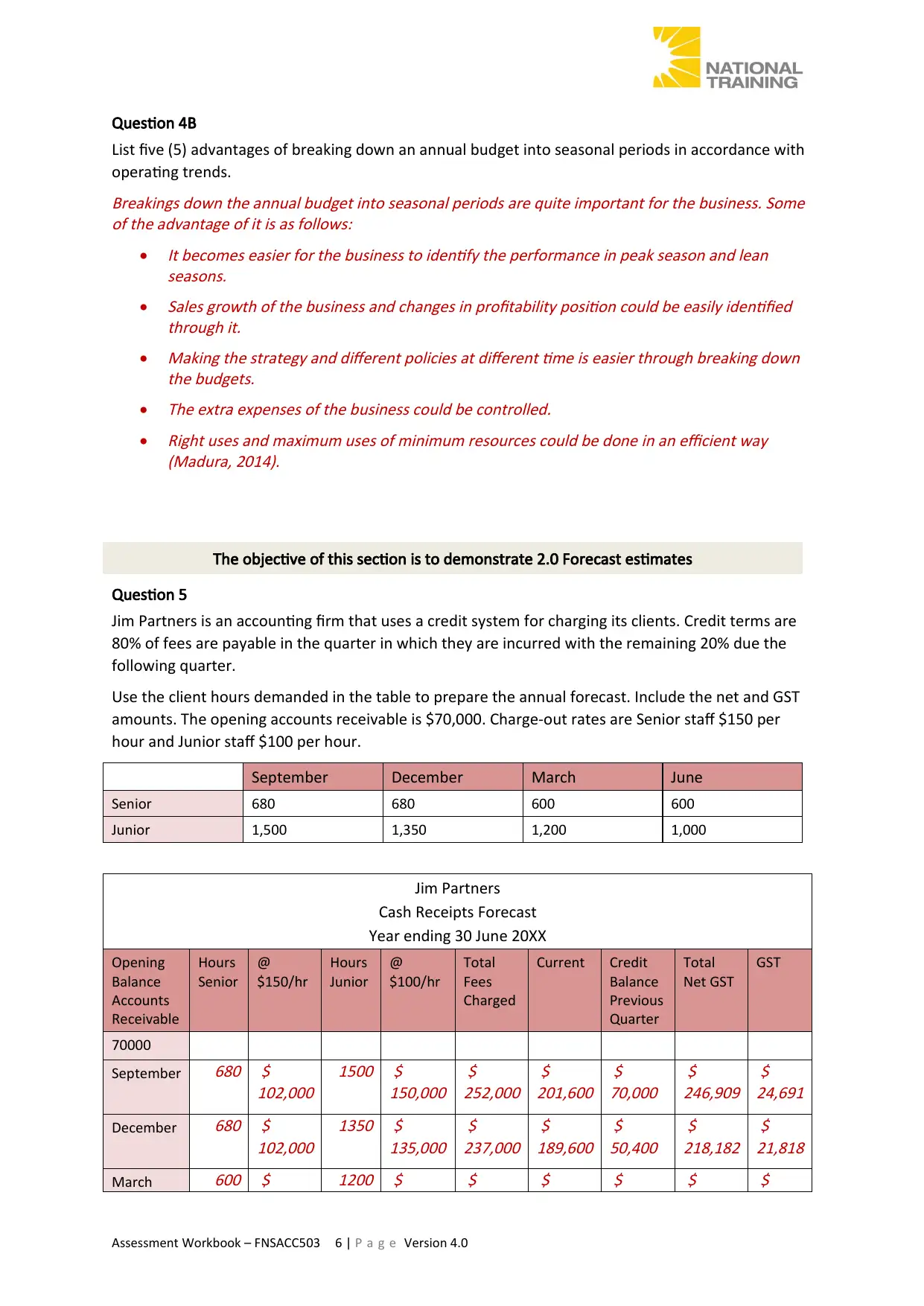
Question 4B
List five (5) advantages of breaking down an annual budget into seasonal periods in accordance with
operating trends.Breakings down the annual budget into seasonal periods are quite important for the business. Some
of the advantage of it is as follows:
It becomes easier for the business to identify the performance in peak season and lean
seasons.
Sales growth of the business and changes in profitability position could be easily identified
through it.
Making the strategy and different policies at different time is easier through breaking down
the budgets.
The extra expenses of the business could be controlled.
Right uses and maximum uses of minimum resources could be done in an efficient way
(Madura, 2014).
The objective of this section is to demonstrate 2.0 Forecast estimates
Question 5
Jim Partners is an accounting firm that uses a credit system for charging its clients. Credit terms are
80% of fees are payable in the quarter in which they are incurred with the remaining 20% due the
following quarter.
Use the client hours demanded in the table to prepare the annual forecast. Include the net and GST
amounts. The opening accounts receivable is $70,000. Charge-out rates are Senior staff $150 per
hour and Junior staff $100 per hour.
September December March June
Senior 680 680 600 600
Junior 1,500 1,350 1,200 1,000
Jim Partners
Cash Receipts Forecast
Year ending 30 June 20XX
Opening
Balance
Accounts
Receivable
Hours
Senior
@
$150/hr
Hours
Junior
@
$100/hr
Total
Fees
Charged
Current Credit
Balance
Previous
Quarter
Total
Net GST
GST
70000
September
680 $
102,000
1500 $
150,000
$
252,000
$
201,600
$
70,000
$
246,909
$
24,691
December
680 $
102,000
1350 $
135,000
$
237,000
$
189,600
$
50,400
$
218,182
$
21,818
March
600 $
1200 $ $ $ $ $ $
Assessment Workbook – FNSACC503 6 | P a g e Version 4.0
List five (5) advantages of breaking down an annual budget into seasonal periods in accordance with
operating trends.Breakings down the annual budget into seasonal periods are quite important for the business. Some
of the advantage of it is as follows:
It becomes easier for the business to identify the performance in peak season and lean
seasons.
Sales growth of the business and changes in profitability position could be easily identified
through it.
Making the strategy and different policies at different time is easier through breaking down
the budgets.
The extra expenses of the business could be controlled.
Right uses and maximum uses of minimum resources could be done in an efficient way
(Madura, 2014).
The objective of this section is to demonstrate 2.0 Forecast estimates
Question 5
Jim Partners is an accounting firm that uses a credit system for charging its clients. Credit terms are
80% of fees are payable in the quarter in which they are incurred with the remaining 20% due the
following quarter.
Use the client hours demanded in the table to prepare the annual forecast. Include the net and GST
amounts. The opening accounts receivable is $70,000. Charge-out rates are Senior staff $150 per
hour and Junior staff $100 per hour.
September December March June
Senior 680 680 600 600
Junior 1,500 1,350 1,200 1,000
Jim Partners
Cash Receipts Forecast
Year ending 30 June 20XX
Opening
Balance
Accounts
Receivable
Hours
Senior
@
$150/hr
Hours
Junior
@
$100/hr
Total
Fees
Charged
Current Credit
Balance
Previous
Quarter
Total
Net GST
GST
70000
September
680 $
102,000
1500 $
150,000
$
252,000
$
201,600
$
70,000
$
246,909
$
24,691
December
680 $
102,000
1350 $
135,000
$
237,000
$
189,600
$
50,400
$
218,182
$
21,818
March
600 $
1200 $ $ $ $ $ $
Assessment Workbook – FNSACC503 6 | P a g e Version 4.0
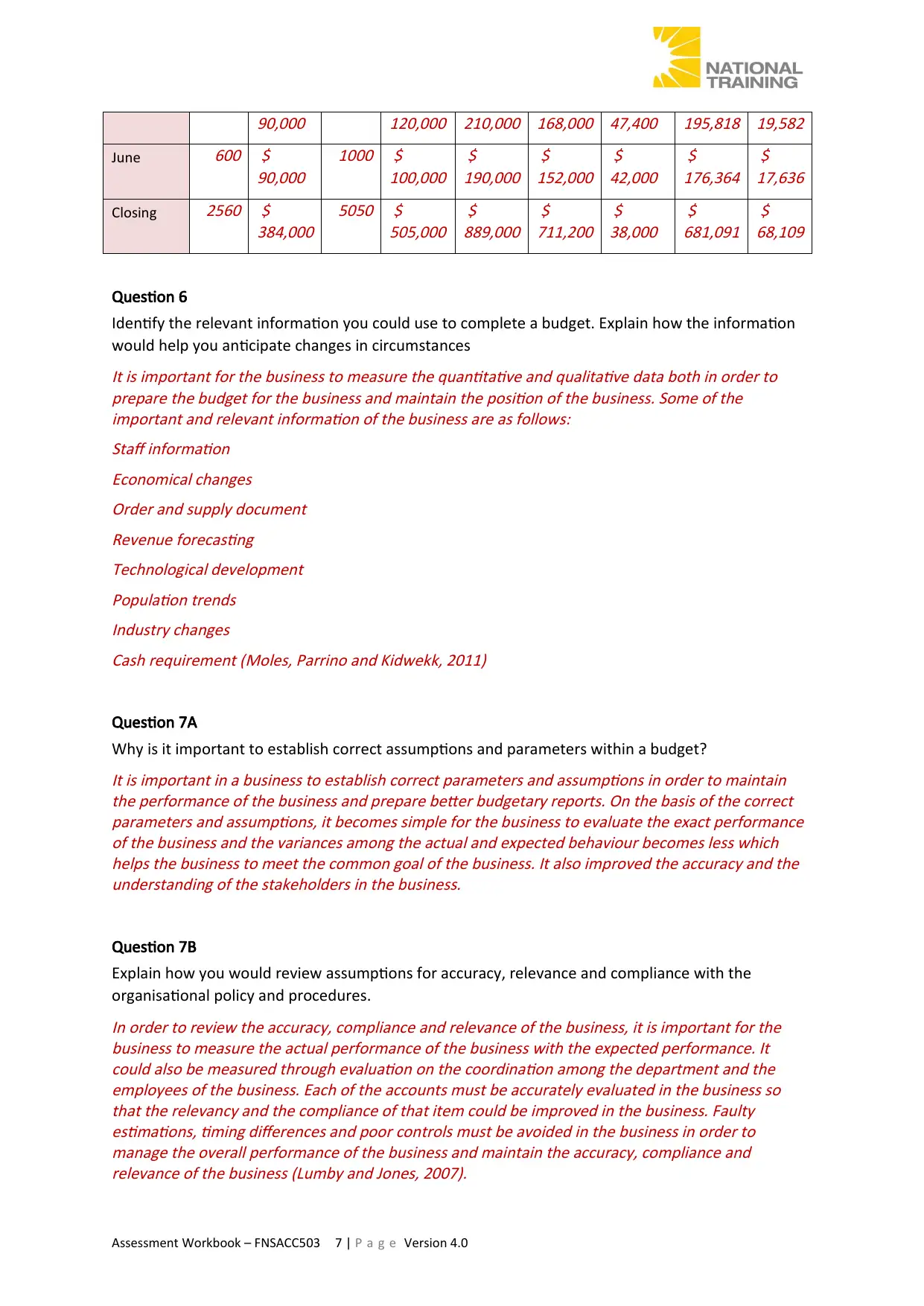
90,000
120,000 210,000 168,000 47,400 195,818 19,582
June
600 $
90,000
1000 $
100,000
$
190,000
$
152,000
$
42,000
$
176,364
$
17,636
Closing
2560 $
384,000
5050 $
505,000
$
889,000
$
711,200
$
38,000
$
681,091
$
68,109
Question 6
Identify the relevant information you could use to complete a budget. Explain how the information
would help you anticipate changes in circumstancesIt is important for the business to measure the quantitative and qualitative data both in order to
prepare the budget for the business and maintain the position of the business. Some of the
important and relevant information of the business are as follows:
Staff information
Economical changes
Order and supply document
Revenue forecasting
Technological development
Population trends
Industry changes
Cash requirement (Moles, Parrino and Kidwekk, 2011)
Question 7A
Why is it important to establish correct assumptions and parameters within a budget?It is important in a business to establish correct parameters and assumptions in order to maintain
the performance of the business and prepare better budgetary reports. On the basis of the correct
parameters and assumptions, it becomes simple for the business to evaluate the exact performance
of the business and the variances among the actual and expected behaviour becomes less which
helps the business to meet the common goal of the business. It also improved the accuracy and the
understanding of the stakeholders in the business.
Question 7B
Explain how you would review assumptions for accuracy, relevance and compliance with the
organisational policy and procedures.In order to review the accuracy, compliance and relevance of the business, it is important for the
business to measure the actual performance of the business with the expected performance. It
could also be measured through evaluation on the coordination among the department and the
employees of the business. Each of the accounts must be accurately evaluated in the business so
that the relevancy and the compliance of that item could be improved in the business. Faulty
estimations, timing differences and poor controls must be avoided in the business in order to
manage the overall performance of the business and maintain the accuracy, compliance and
relevance of the business (Lumby and Jones, 2007).
Assessment Workbook – FNSACC503 7 | P a g e Version 4.0
120,000 210,000 168,000 47,400 195,818 19,582
June
600 $
90,000
1000 $
100,000
$
190,000
$
152,000
$
42,000
$
176,364
$
17,636
Closing
2560 $
384,000
5050 $
505,000
$
889,000
$
711,200
$
38,000
$
681,091
$
68,109
Question 6
Identify the relevant information you could use to complete a budget. Explain how the information
would help you anticipate changes in circumstancesIt is important for the business to measure the quantitative and qualitative data both in order to
prepare the budget for the business and maintain the position of the business. Some of the
important and relevant information of the business are as follows:
Staff information
Economical changes
Order and supply document
Revenue forecasting
Technological development
Population trends
Industry changes
Cash requirement (Moles, Parrino and Kidwekk, 2011)
Question 7A
Why is it important to establish correct assumptions and parameters within a budget?It is important in a business to establish correct parameters and assumptions in order to maintain
the performance of the business and prepare better budgetary reports. On the basis of the correct
parameters and assumptions, it becomes simple for the business to evaluate the exact performance
of the business and the variances among the actual and expected behaviour becomes less which
helps the business to meet the common goal of the business. It also improved the accuracy and the
understanding of the stakeholders in the business.
Question 7B
Explain how you would review assumptions for accuracy, relevance and compliance with the
organisational policy and procedures.In order to review the accuracy, compliance and relevance of the business, it is important for the
business to measure the actual performance of the business with the expected performance. It
could also be measured through evaluation on the coordination among the department and the
employees of the business. Each of the accounts must be accurately evaluated in the business so
that the relevancy and the compliance of that item could be improved in the business. Faulty
estimations, timing differences and poor controls must be avoided in the business in order to
manage the overall performance of the business and maintain the accuracy, compliance and
relevance of the business (Lumby and Jones, 2007).
Assessment Workbook – FNSACC503 7 | P a g e Version 4.0
Paraphrase This Document
Need a fresh take? Get an instant paraphrase of this document with our AI Paraphraser
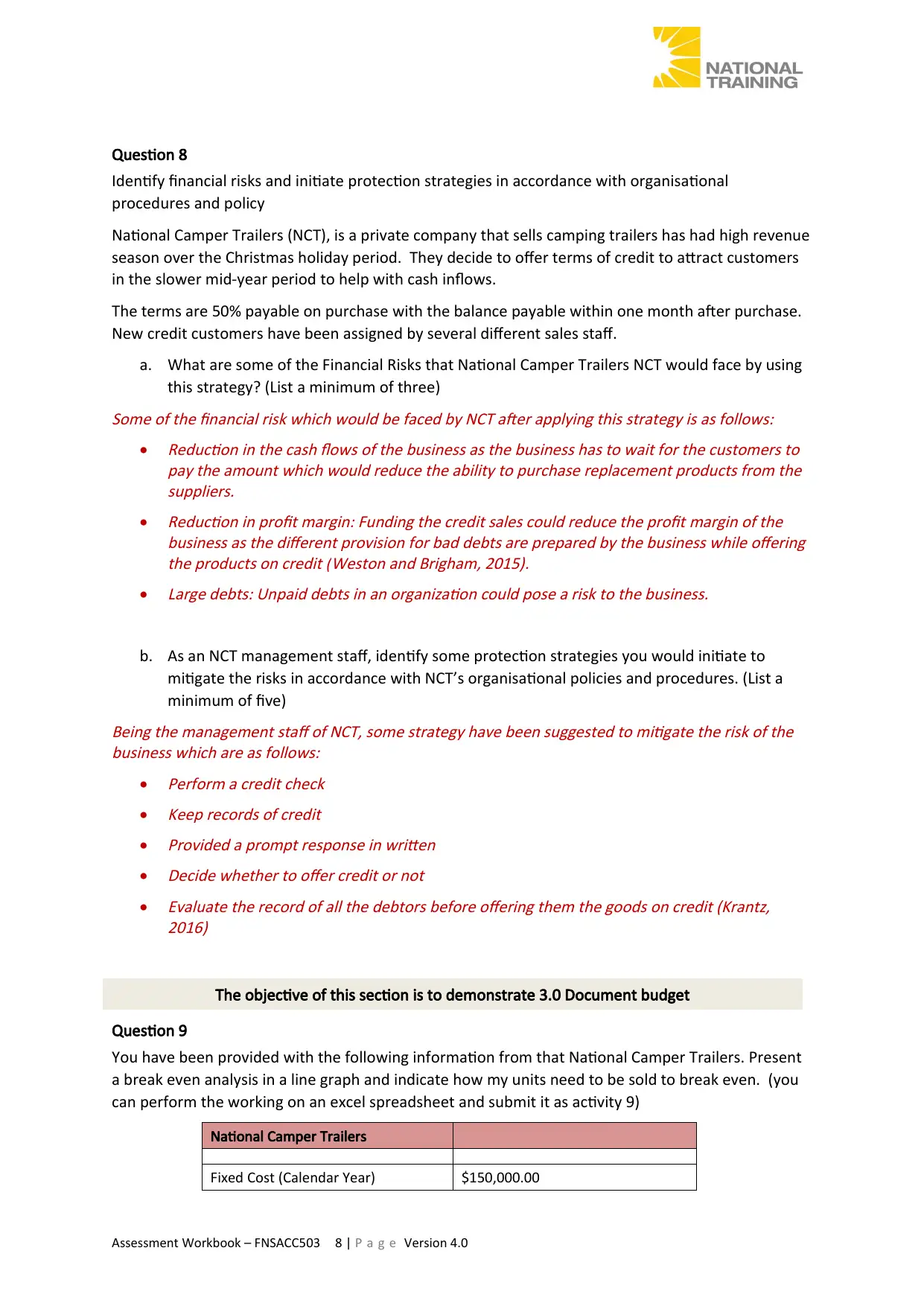
Question 8
Identify financial risks and initiate protection strategies in accordance with organisational
procedures and policy
National Camper Trailers (NCT), is a private company that sells camping trailers has had high revenue
season over the Christmas holiday period. They decide to offer terms of credit to attract customers
in the slower mid-year period to help with cash inflows.
The terms are 50% payable on purchase with the balance payable within one month after purchase.
New credit customers have been assigned by several different sales staff.
a. What are some of the Financial Risks that National Camper Trailers NCT would face by using
this strategy? (List a minimum of three)Some of the financial risk which would be faced by NCT after applying this strategy is as follows:
Reduction in the cash flows of the business as the business has to wait for the customers to
pay the amount which would reduce the ability to purchase replacement products from the
suppliers.
Reduction in profit margin: Funding the credit sales could reduce the profit margin of the
business as the different provision for bad debts are prepared by the business while offering
the products on credit (Weston and Brigham, 2015).
Large debts: Unpaid debts in an organization could pose a risk to the business.
b. As an NCT management staff, identify some protection strategies you would initiate to
mitigate the risks in accordance with NCT’s organisational policies and procedures. (List a
minimum of five)Being the management staff of NCT, some strategy have been suggested to mitigate the risk of the
business which are as follows:
Perform a credit check
Keep records of credit
Provided a prompt response in written
Decide whether to offer credit or not
Evaluate the record of all the debtors before offering them the goods on credit (Krantz,
2016)
The objective of this section is to demonstrate 3.0 Document budget
Question 9
You have been provided with the following information from that National Camper Trailers. Present
a break even analysis in a line graph and indicate how my units need to be sold to break even. (you
can perform the working on an excel spreadsheet and submit it as activity 9)
National Camper Trailers
Fixed Cost (Calendar Year) $150,000.00
Assessment Workbook – FNSACC503 8 | P a g e Version 4.0
Identify financial risks and initiate protection strategies in accordance with organisational
procedures and policy
National Camper Trailers (NCT), is a private company that sells camping trailers has had high revenue
season over the Christmas holiday period. They decide to offer terms of credit to attract customers
in the slower mid-year period to help with cash inflows.
The terms are 50% payable on purchase with the balance payable within one month after purchase.
New credit customers have been assigned by several different sales staff.
a. What are some of the Financial Risks that National Camper Trailers NCT would face by using
this strategy? (List a minimum of three)Some of the financial risk which would be faced by NCT after applying this strategy is as follows:
Reduction in the cash flows of the business as the business has to wait for the customers to
pay the amount which would reduce the ability to purchase replacement products from the
suppliers.
Reduction in profit margin: Funding the credit sales could reduce the profit margin of the
business as the different provision for bad debts are prepared by the business while offering
the products on credit (Weston and Brigham, 2015).
Large debts: Unpaid debts in an organization could pose a risk to the business.
b. As an NCT management staff, identify some protection strategies you would initiate to
mitigate the risks in accordance with NCT’s organisational policies and procedures. (List a
minimum of five)Being the management staff of NCT, some strategy have been suggested to mitigate the risk of the
business which are as follows:
Perform a credit check
Keep records of credit
Provided a prompt response in written
Decide whether to offer credit or not
Evaluate the record of all the debtors before offering them the goods on credit (Krantz,
2016)
The objective of this section is to demonstrate 3.0 Document budget
Question 9
You have been provided with the following information from that National Camper Trailers. Present
a break even analysis in a line graph and indicate how my units need to be sold to break even. (you
can perform the working on an excel spreadsheet and submit it as activity 9)
National Camper Trailers
Fixed Cost (Calendar Year) $150,000.00
Assessment Workbook – FNSACC503 8 | P a g e Version 4.0
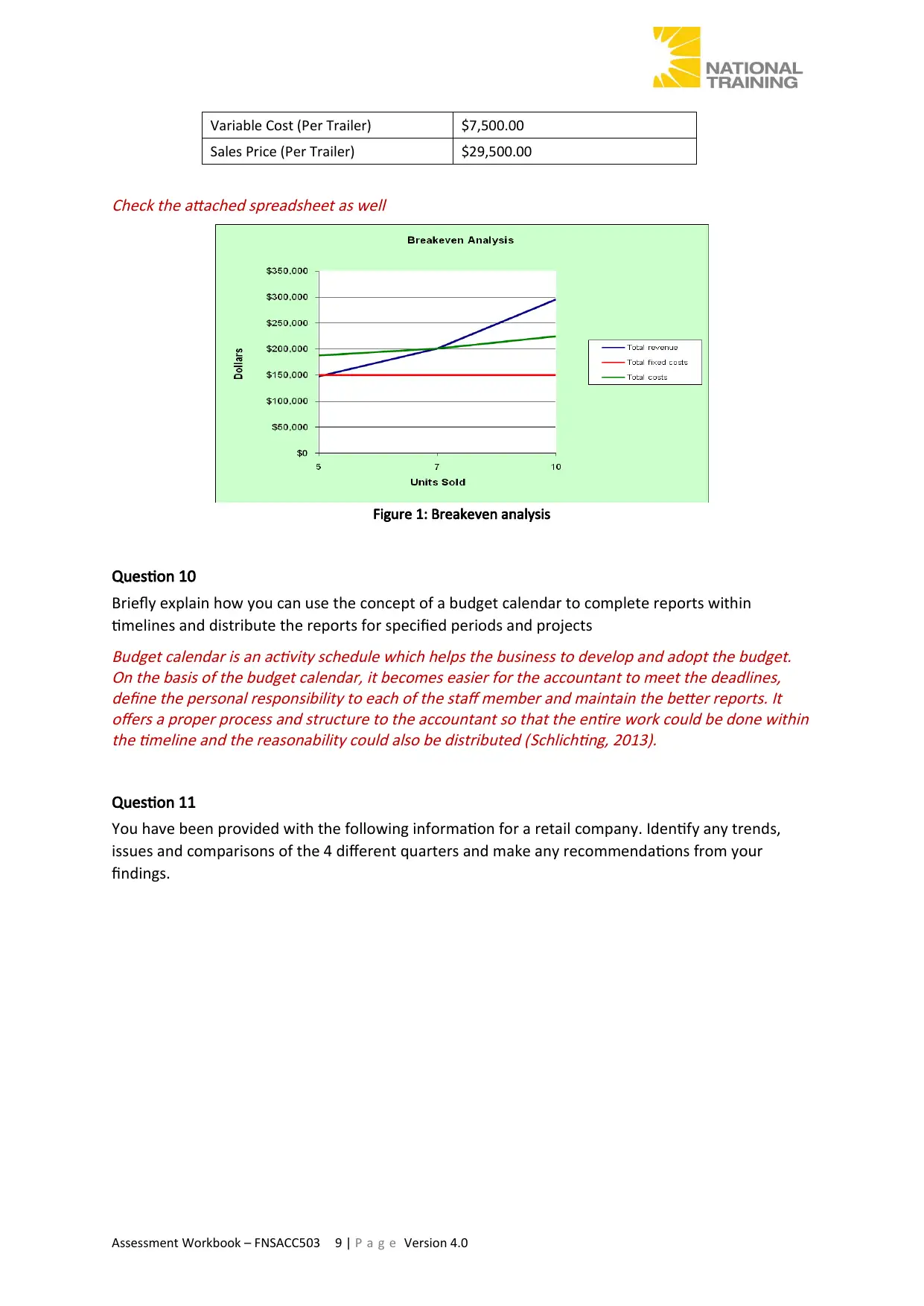
Variable Cost (Per Trailer) $7,500.00
Sales Price (Per Trailer) $29,500.00
Check the attached spreadsheet as well
Figure 1: Breakeven analysis
Question 10
Briefly explain how you can use the concept of a budget calendar to complete reports within
timelines and distribute the reports for specified periods and projectsBudget calendar is an activity schedule which helps the business to develop and adopt the budget.
On the basis of the budget calendar, it becomes easier for the accountant to meet the deadlines,
define the personal responsibility to each of the staff member and maintain the better reports. It
offers a proper process and structure to the accountant so that the entire work could be done within
the timeline and the reasonability could also be distributed (Schlichting, 2013).
Question 11
You have been provided with the following information for a retail company. Identify any trends,
issues and comparisons of the 4 different quarters and make any recommendations from your
findings.
Assessment Workbook – FNSACC503 9 | P a g e Version 4.0
Sales Price (Per Trailer) $29,500.00
Check the attached spreadsheet as well
Figure 1: Breakeven analysis
Question 10
Briefly explain how you can use the concept of a budget calendar to complete reports within
timelines and distribute the reports for specified periods and projectsBudget calendar is an activity schedule which helps the business to develop and adopt the budget.
On the basis of the budget calendar, it becomes easier for the accountant to meet the deadlines,
define the personal responsibility to each of the staff member and maintain the better reports. It
offers a proper process and structure to the accountant so that the entire work could be done within
the timeline and the reasonability could also be distributed (Schlichting, 2013).
Question 11
You have been provided with the following information for a retail company. Identify any trends,
issues and comparisons of the 4 different quarters and make any recommendations from your
findings.
Assessment Workbook – FNSACC503 9 | P a g e Version 4.0
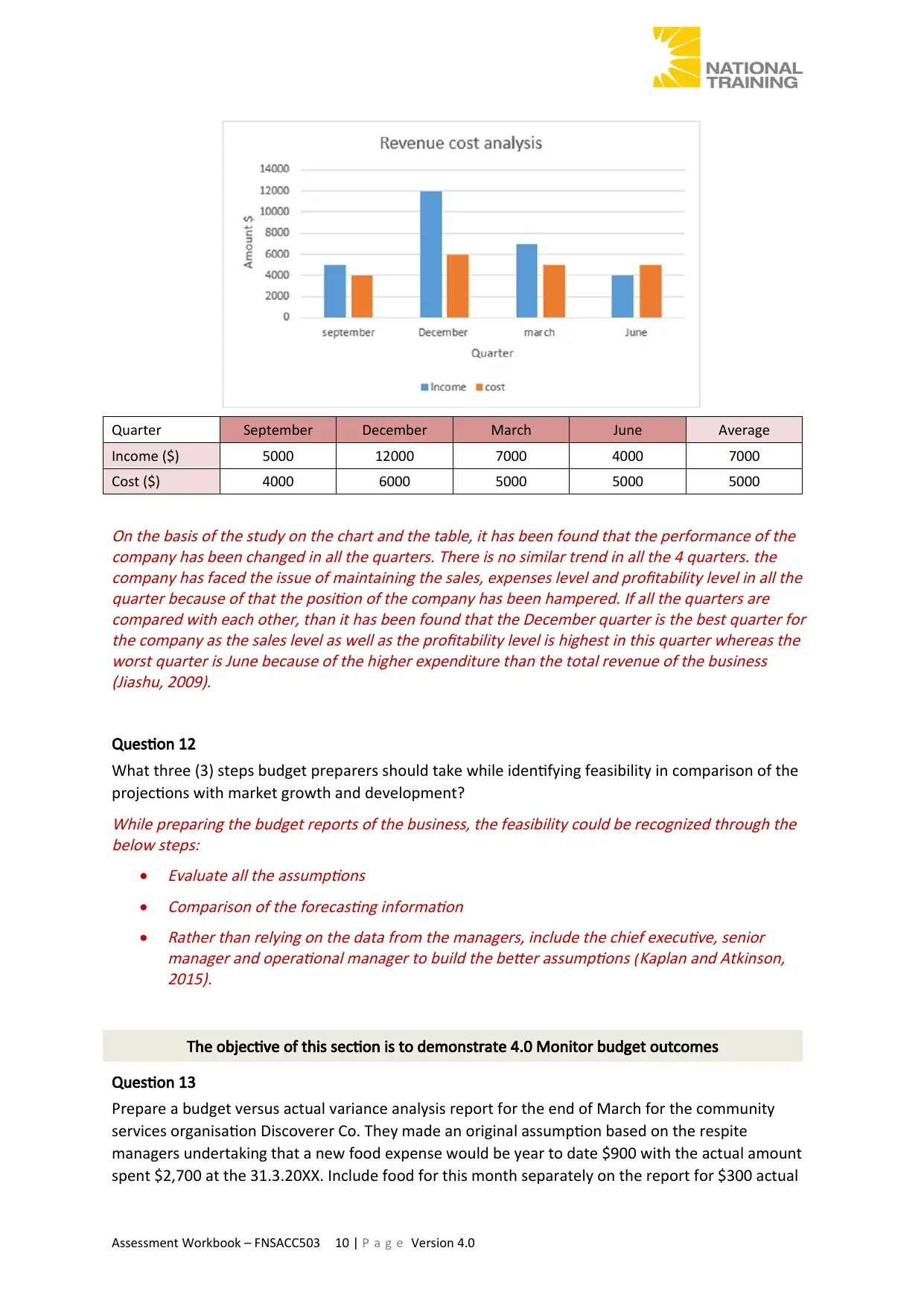
Quarter September December March June Average
Income ($) 5000 12000 7000 4000 7000
Cost ($) 4000 6000 5000 5000 5000
On the basis of the study on the chart and the table, it has been found that the performance of the
company has been changed in all the quarters. There is no similar trend in all the 4 quarters. the
company has faced the issue of maintaining the sales, expenses level and profitability level in all the
quarter because of that the position of the company has been hampered. If all the quarters are
compared with each other, than it has been found that the December quarter is the best quarter for
the company as the sales level as well as the profitability level is highest in this quarter whereas the
worst quarter is June because of the higher expenditure than the total revenue of the business
(Jiashu, 2009).
Question 12
What three (3) steps budget preparers should take while identifying feasibility in comparison of the
projections with market growth and development?While preparing the budget reports of the business, the feasibility could be recognized through the
below steps:
Evaluate all the assumptions
Comparison of the forecasting information
Rather than relying on the data from the managers, include the chief executive, senior
manager and operational manager to build the better assumptions (Kaplan and Atkinson,
2015).
The objective of this section is to demonstrate 4.0 Monitor budget outcomes
Question 13
Prepare a budget versus actual variance analysis report for the end of March for the community
services organisation Discoverer Co. They made an original assumption based on the respite
managers undertaking that a new food expense would be year to date $900 with the actual amount
spent $2,700 at the 31.3.20XX. Include food for this month separately on the report for $300 actual
Assessment Workbook – FNSACC503 10 | P a g e Version 4.0
Income ($) 5000 12000 7000 4000 7000
Cost ($) 4000 6000 5000 5000 5000
On the basis of the study on the chart and the table, it has been found that the performance of the
company has been changed in all the quarters. There is no similar trend in all the 4 quarters. the
company has faced the issue of maintaining the sales, expenses level and profitability level in all the
quarter because of that the position of the company has been hampered. If all the quarters are
compared with each other, than it has been found that the December quarter is the best quarter for
the company as the sales level as well as the profitability level is highest in this quarter whereas the
worst quarter is June because of the higher expenditure than the total revenue of the business
(Jiashu, 2009).
Question 12
What three (3) steps budget preparers should take while identifying feasibility in comparison of the
projections with market growth and development?While preparing the budget reports of the business, the feasibility could be recognized through the
below steps:
Evaluate all the assumptions
Comparison of the forecasting information
Rather than relying on the data from the managers, include the chief executive, senior
manager and operational manager to build the better assumptions (Kaplan and Atkinson,
2015).
The objective of this section is to demonstrate 4.0 Monitor budget outcomes
Question 13
Prepare a budget versus actual variance analysis report for the end of March for the community
services organisation Discoverer Co. They made an original assumption based on the respite
managers undertaking that a new food expense would be year to date $900 with the actual amount
spent $2,700 at the 31.3.20XX. Include food for this month separately on the report for $300 actual
Assessment Workbook – FNSACC503 10 | P a g e Version 4.0
Secure Best Marks with AI Grader
Need help grading? Try our AI Grader for instant feedback on your assignments.
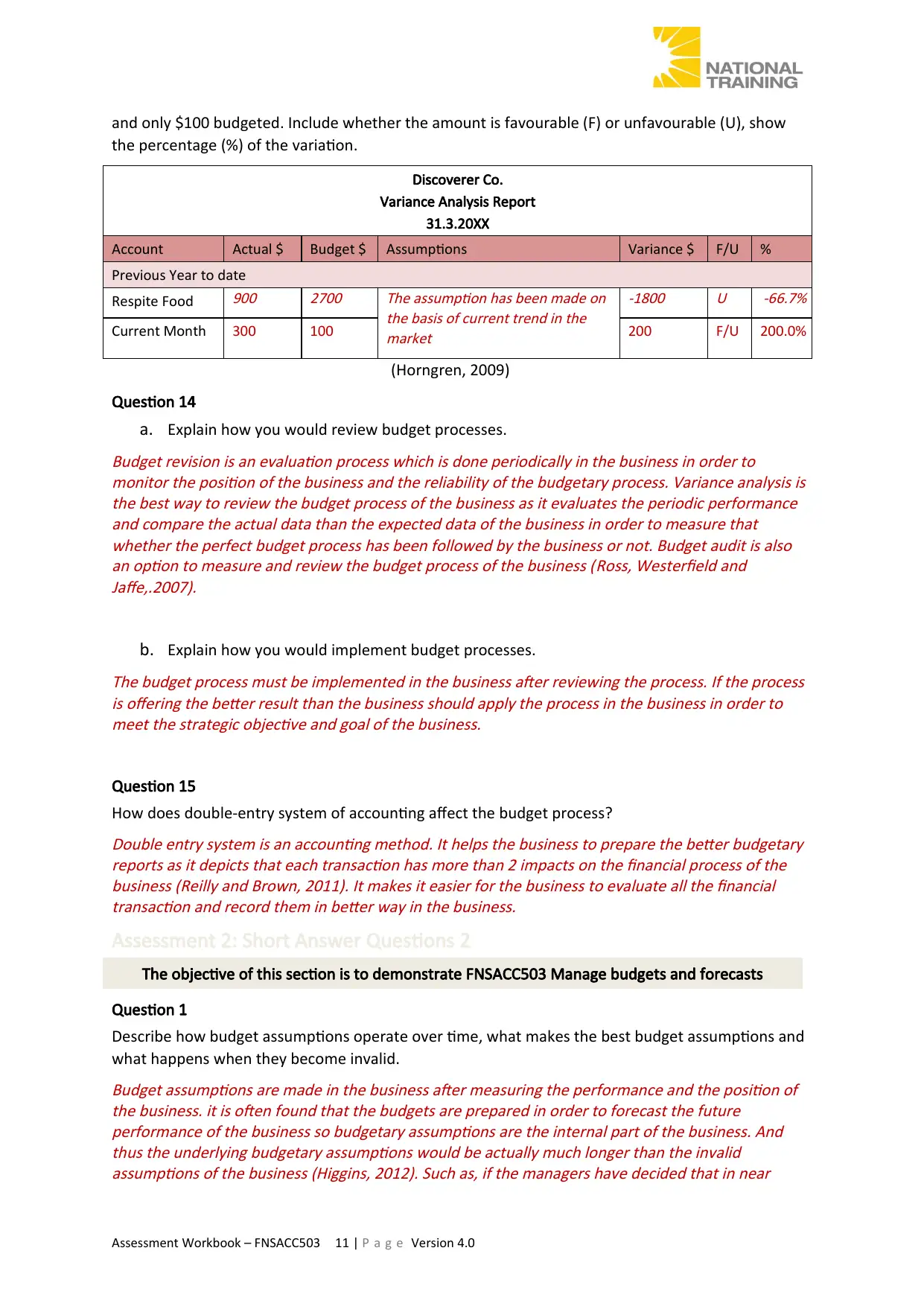
and only $100 budgeted. Include whether the amount is favourable (F) or unfavourable (U), show
the percentage (%) of the variation.
Discoverer Co.
Variance Analysis Report
31.3.20XX
Account Actual $ Budget $ Assumptions Variance $ F/U %
Previous Year to date
Respite Food
900 2700 The assumption has been made on
the basis of current trend in the
market
-1800 U -66.7%
Current Month 300 100 200 F/U 200.0%
(Horngren, 2009)
Question 14
a. Explain how you would review budget processes.Budget revision is an evaluation process which is done periodically in the business in order to
monitor the position of the business and the reliability of the budgetary process. Variance analysis is
the best way to review the budget process of the business as it evaluates the periodic performance
and compare the actual data than the expected data of the business in order to measure that
whether the perfect budget process has been followed by the business or not. Budget audit is also
an option to measure and review the budget process of the business (Ross, Westerfield and
Jaffe,.2007).
b. Explain how you would implement budget processes.The budget process must be implemented in the business after reviewing the process. If the process
is offering the better result than the business should apply the process in the business in order to
meet the strategic objective and goal of the business.
Question 15
How does double-entry system of accounting affect the budget process?Double entry system is an accounting method. It helps the business to prepare the better budgetary
reports as it depicts that each transaction has more than 2 impacts on the financial process of the
business (Reilly and Brown, 2011). It makes it easier for the business to evaluate all the financial
transaction and record them in better way in the business.
Assessment 2: Short Answer Questions 2
The objective of this section is to demonstrate FNSACC503 Manage budgets and forecasts
Question 1
Describe how budget assumptions operate over time, what makes the best budget assumptions and
what happens when they become invalid.Budget assumptions are made in the business after measuring the performance and the position of
the business. it is often found that the budgets are prepared in order to forecast the future
performance of the business so budgetary assumptions are the internal part of the business. And
thus the underlying budgetary assumptions would be actually much longer than the invalid
assumptions of the business (Higgins, 2012). Such as, if the managers have decided that in near
Assessment Workbook – FNSACC503 11 | P a g e Version 4.0
the percentage (%) of the variation.
Discoverer Co.
Variance Analysis Report
31.3.20XX
Account Actual $ Budget $ Assumptions Variance $ F/U %
Previous Year to date
Respite Food
900 2700 The assumption has been made on
the basis of current trend in the
market
-1800 U -66.7%
Current Month 300 100 200 F/U 200.0%
(Horngren, 2009)
Question 14
a. Explain how you would review budget processes.Budget revision is an evaluation process which is done periodically in the business in order to
monitor the position of the business and the reliability of the budgetary process. Variance analysis is
the best way to review the budget process of the business as it evaluates the periodic performance
and compare the actual data than the expected data of the business in order to measure that
whether the perfect budget process has been followed by the business or not. Budget audit is also
an option to measure and review the budget process of the business (Ross, Westerfield and
Jaffe,.2007).
b. Explain how you would implement budget processes.The budget process must be implemented in the business after reviewing the process. If the process
is offering the better result than the business should apply the process in the business in order to
meet the strategic objective and goal of the business.
Question 15
How does double-entry system of accounting affect the budget process?Double entry system is an accounting method. It helps the business to prepare the better budgetary
reports as it depicts that each transaction has more than 2 impacts on the financial process of the
business (Reilly and Brown, 2011). It makes it easier for the business to evaluate all the financial
transaction and record them in better way in the business.
Assessment 2: Short Answer Questions 2
The objective of this section is to demonstrate FNSACC503 Manage budgets and forecasts
Question 1
Describe how budget assumptions operate over time, what makes the best budget assumptions and
what happens when they become invalid.Budget assumptions are made in the business after measuring the performance and the position of
the business. it is often found that the budgets are prepared in order to forecast the future
performance of the business so budgetary assumptions are the internal part of the business. And
thus the underlying budgetary assumptions would be actually much longer than the invalid
assumptions of the business (Higgins, 2012). Such as, if the managers have decided that in near
Assessment Workbook – FNSACC503 11 | P a g e Version 4.0
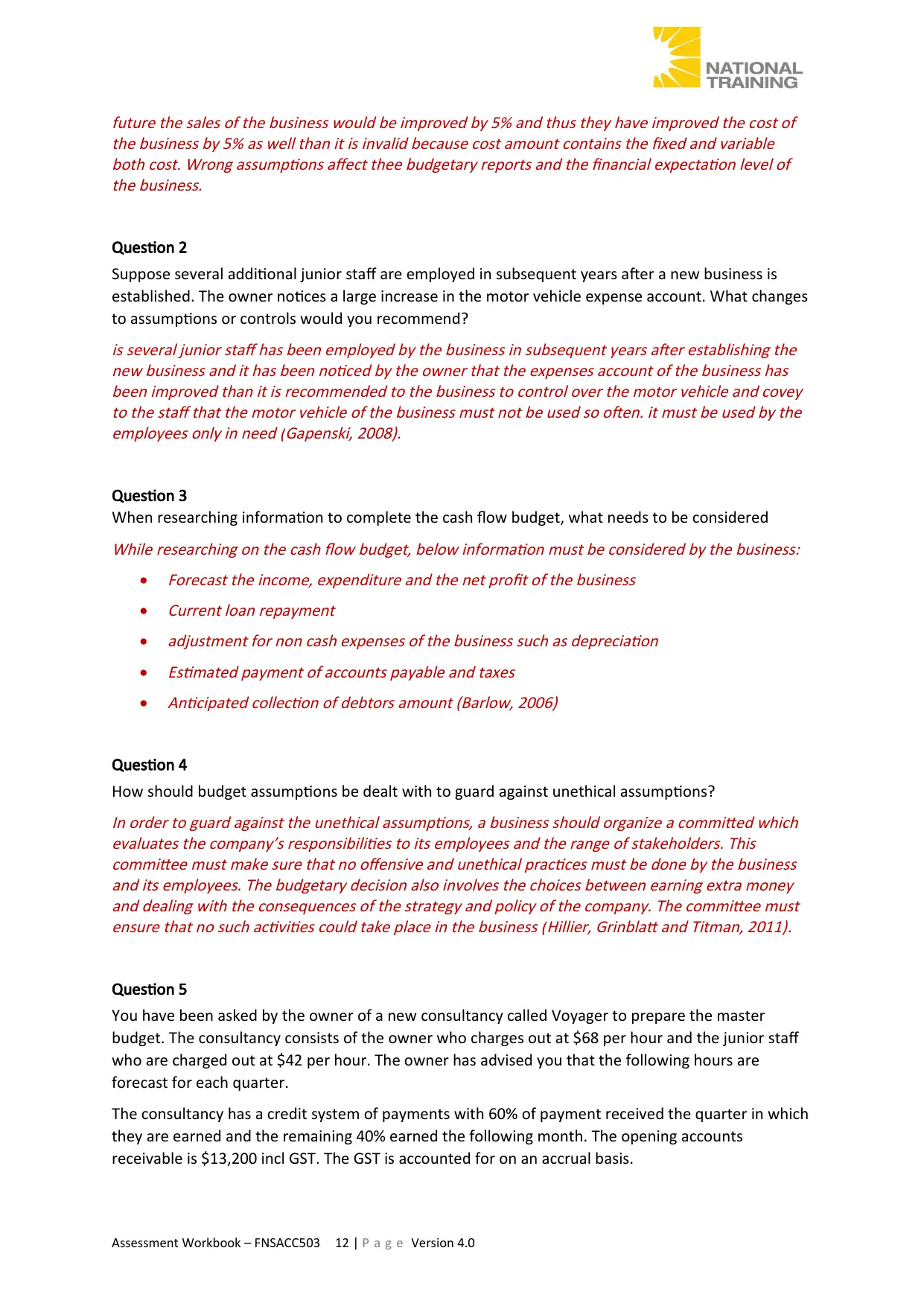
future the sales of the business would be improved by 5% and thus they have improved the cost of
the business by 5% as well than it is invalid because cost amount contains the fixed and variable
both cost. Wrong assumptions affect thee budgetary reports and the financial expectation level of
the business.
Question 2
Suppose several additional junior staff are employed in subsequent years after a new business is
established. The owner notices a large increase in the motor vehicle expense account. What changes
to assumptions or controls would you recommend?is several junior staff has been employed by the business in subsequent years after establishing the
new business and it has been noticed by the owner that the expenses account of the business has
been improved than it is recommended to the business to control over the motor vehicle and covey
to the staff that the motor vehicle of the business must not be used so often. it must be used by the
employees only in need (Gapenski, 2008).
Question 3
When researching information to complete the cash flow budget, what needs to be consideredWhile researching on the cash flow budget, below information must be considered by the business:
Forecast the income, expenditure and the net profit of the business
Current loan repayment
adjustment for non cash expenses of the business such as depreciation
Estimated payment of accounts payable and taxes
Anticipated collection of debtors amount (Barlow, 2006)
Question 4
How should budget assumptions be dealt with to guard against unethical assumptions?In order to guard against the unethical assumptions, a business should organize a committed which
evaluates the company’s responsibilities to its employees and the range of stakeholders. This
committee must make sure that no offensive and unethical practices must be done by the business
and its employees. The budgetary decision also involves the choices between earning extra money
and dealing with the consequences of the strategy and policy of the company. The committee must
ensure that no such activities could take place in the business (Hillier, Grinblatt and Titman, 2011).
Question 5
You have been asked by the owner of a new consultancy called Voyager to prepare the master
budget. The consultancy consists of the owner who charges out at $68 per hour and the junior staff
who are charged out at $42 per hour. The owner has advised you that the following hours are
forecast for each quarter.
The consultancy has a credit system of payments with 60% of payment received the quarter in which
they are earned and the remaining 40% earned the following month. The opening accounts
receivable is $13,200 incl GST. The GST is accounted for on an accrual basis.
Assessment Workbook – FNSACC503 12 | P a g e Version 4.0
the business by 5% as well than it is invalid because cost amount contains the fixed and variable
both cost. Wrong assumptions affect thee budgetary reports and the financial expectation level of
the business.
Question 2
Suppose several additional junior staff are employed in subsequent years after a new business is
established. The owner notices a large increase in the motor vehicle expense account. What changes
to assumptions or controls would you recommend?is several junior staff has been employed by the business in subsequent years after establishing the
new business and it has been noticed by the owner that the expenses account of the business has
been improved than it is recommended to the business to control over the motor vehicle and covey
to the staff that the motor vehicle of the business must not be used so often. it must be used by the
employees only in need (Gapenski, 2008).
Question 3
When researching information to complete the cash flow budget, what needs to be consideredWhile researching on the cash flow budget, below information must be considered by the business:
Forecast the income, expenditure and the net profit of the business
Current loan repayment
adjustment for non cash expenses of the business such as depreciation
Estimated payment of accounts payable and taxes
Anticipated collection of debtors amount (Barlow, 2006)
Question 4
How should budget assumptions be dealt with to guard against unethical assumptions?In order to guard against the unethical assumptions, a business should organize a committed which
evaluates the company’s responsibilities to its employees and the range of stakeholders. This
committee must make sure that no offensive and unethical practices must be done by the business
and its employees. The budgetary decision also involves the choices between earning extra money
and dealing with the consequences of the strategy and policy of the company. The committee must
ensure that no such activities could take place in the business (Hillier, Grinblatt and Titman, 2011).
Question 5
You have been asked by the owner of a new consultancy called Voyager to prepare the master
budget. The consultancy consists of the owner who charges out at $68 per hour and the junior staff
who are charged out at $42 per hour. The owner has advised you that the following hours are
forecast for each quarter.
The consultancy has a credit system of payments with 60% of payment received the quarter in which
they are earned and the remaining 40% earned the following month. The opening accounts
receivable is $13,200 incl GST. The GST is accounted for on an accrual basis.
Assessment Workbook – FNSACC503 12 | P a g e Version 4.0
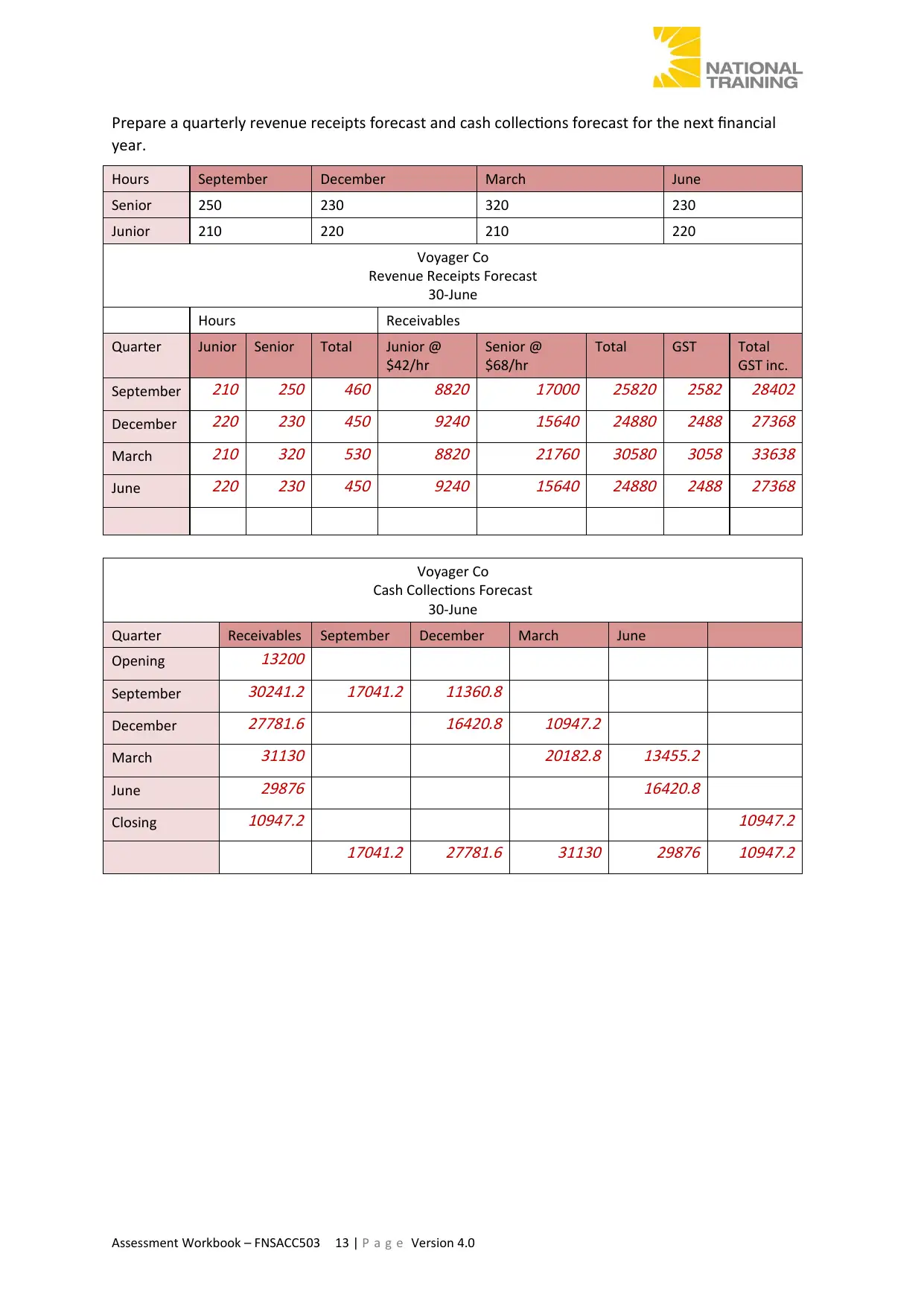
Prepare a quarterly revenue receipts forecast and cash collections forecast for the next financial
year.
Hours September December March June
Senior 250 230 320 230
Junior 210 220 210 220
Voyager Co
Revenue Receipts Forecast
30-June
Hours Receivables
Quarter Junior Senior Total Junior @
$42/hr
Senior @
$68/hr
Total GST Total
GST inc.
September
210 250 460 8820
17000 25820 2582 28402
December
220 230 450 9240
15640 24880 2488 27368
March
210 320 530 8820
21760 30580 3058 33638
June
220 230 450 9240
15640 24880 2488 27368
Voyager Co
Cash Collections Forecast
30-June
Quarter Receivables September December March June
Opening
13200
September
30241.2 17041.2 11360.8
December
27781.6
16420.8 10947.2
March
31130
20182.8 13455.2
June
29876
16420.8
Closing
10947.2
10947.2
17041.2 27781.6 31130 29876 10947.2
Assessment Workbook – FNSACC503 13 | P a g e Version 4.0
year.
Hours September December March June
Senior 250 230 320 230
Junior 210 220 210 220
Voyager Co
Revenue Receipts Forecast
30-June
Hours Receivables
Quarter Junior Senior Total Junior @
$42/hr
Senior @
$68/hr
Total GST Total
GST inc.
September
210 250 460 8820
17000 25820 2582 28402
December
220 230 450 9240
15640 24880 2488 27368
March
210 320 530 8820
21760 30580 3058 33638
June
220 230 450 9240
15640 24880 2488 27368
Voyager Co
Cash Collections Forecast
30-June
Quarter Receivables September December March June
Opening
13200
September
30241.2 17041.2 11360.8
December
27781.6
16420.8 10947.2
March
31130
20182.8 13455.2
June
29876
16420.8
Closing
10947.2
10947.2
17041.2 27781.6 31130 29876 10947.2
Assessment Workbook – FNSACC503 13 | P a g e Version 4.0
Paraphrase This Document
Need a fresh take? Get an instant paraphrase of this document with our AI Paraphraser
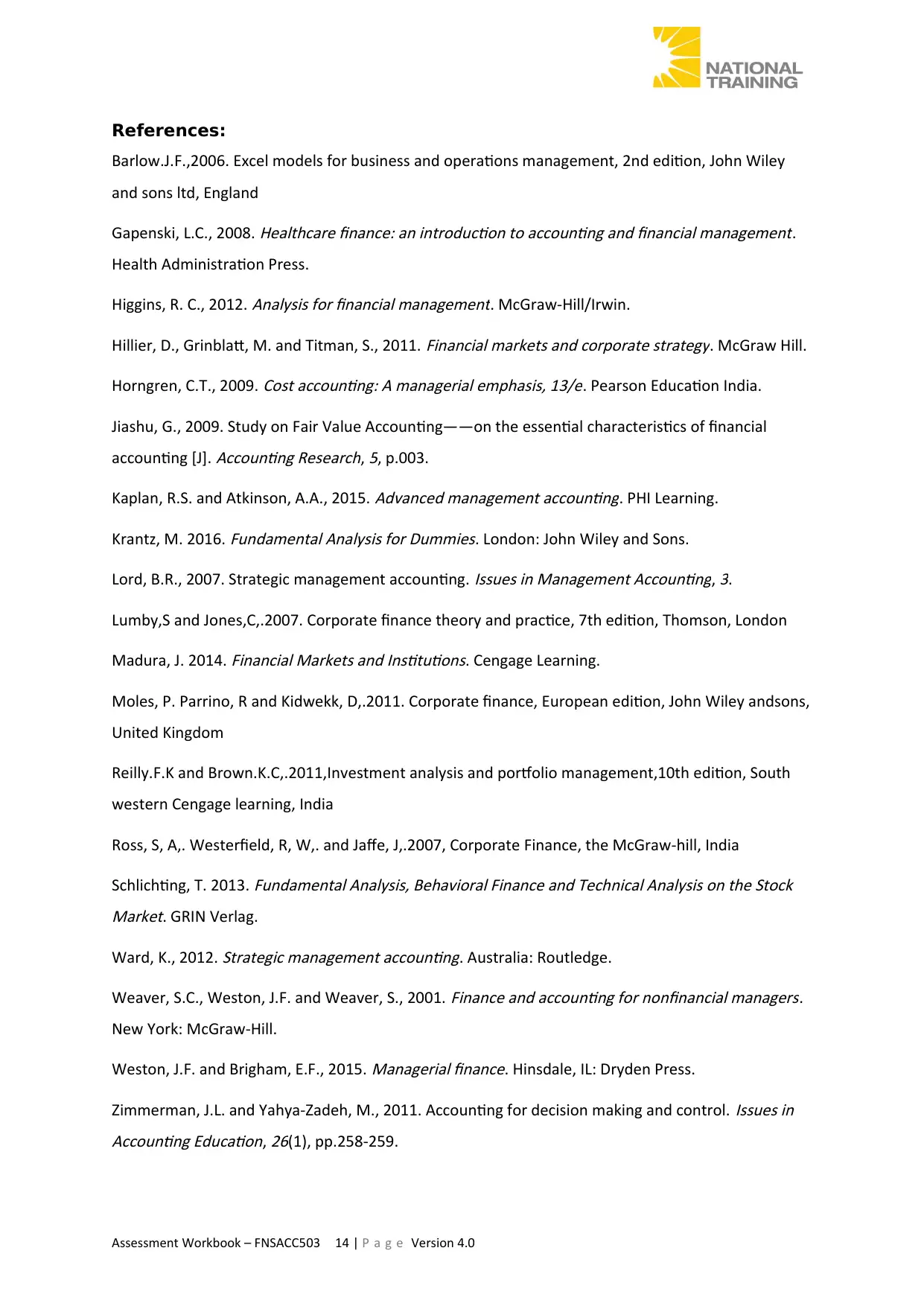
References:
Barlow.J.F.,2006. Excel models for business and operations management, 2nd edition, John Wiley
and sons ltd, England
Gapenski, L.C., 2008.
Healthcare finance: an introduction to accounting and financial management.
Health Administration Press.
Higgins, R. C., 2012.
Analysis for financial management. McGraw-Hill/Irwin.
Hillier, D., Grinblatt, M. and Titman, S., 2011.
Financial markets and corporate strategy. McGraw Hill.
Horngren, C.T., 2009.
Cost accounting: A managerial emphasis, 13/e. Pearson Education India.
Jiashu, G., 2009. Study on Fair Value Accounting——on the essential characteristics of financial
accounting [J].
Accounting Research,
5, p.003.
Kaplan, R.S. and Atkinson, A.A., 2015.
Advanced management accounting. PHI Learning.
Krantz, M. 2016.
Fundamental Analysis for Dummies. London: John Wiley and Sons.
Lord, B.R., 2007. Strategic management accounting.
Issues in Management Accounting,
3.
Lumby,S and Jones,C,.2007. Corporate finance theory and practice, 7th edition, Thomson, London
Madura, J. 2014.
Financial Markets and Institutions. Cengage Learning.
Moles, P. Parrino, R and Kidwekk, D,.2011. Corporate finance, European edition, John Wiley andsons,
United Kingdom
Reilly.F.K and Brown.K.C,.2011,Investment analysis and portfolio management,10th edition, South
western Cengage learning, India
Ross, S, A,. Westerfield, R, W,. and Jaffe, J,.2007, Corporate Finance, the McGraw-hill, India
Schlichting, T. 2013.
Fundamental Analysis, Behavioral Finance and Technical Analysis on the Stock
Market. GRIN Verlag.
Ward, K., 2012.
Strategic management accounting. Australia: Routledge.
Weaver, S.C., Weston, J.F. and Weaver, S., 2001.
Finance and accounting for nonfinancial managers.
New York: McGraw-Hill.
Weston, J.F. and Brigham, E.F., 2015.
Managerial finance. Hinsdale, IL: Dryden Press.
Zimmerman, J.L. and Yahya-Zadeh, M., 2011. Accounting for decision making and control.
Issues in
Accounting Education,
26(1), pp.258-259.
Assessment Workbook – FNSACC503 14 | P a g e Version 4.0
Barlow.J.F.,2006. Excel models for business and operations management, 2nd edition, John Wiley
and sons ltd, England
Gapenski, L.C., 2008.
Healthcare finance: an introduction to accounting and financial management.
Health Administration Press.
Higgins, R. C., 2012.
Analysis for financial management. McGraw-Hill/Irwin.
Hillier, D., Grinblatt, M. and Titman, S., 2011.
Financial markets and corporate strategy. McGraw Hill.
Horngren, C.T., 2009.
Cost accounting: A managerial emphasis, 13/e. Pearson Education India.
Jiashu, G., 2009. Study on Fair Value Accounting——on the essential characteristics of financial
accounting [J].
Accounting Research,
5, p.003.
Kaplan, R.S. and Atkinson, A.A., 2015.
Advanced management accounting. PHI Learning.
Krantz, M. 2016.
Fundamental Analysis for Dummies. London: John Wiley and Sons.
Lord, B.R., 2007. Strategic management accounting.
Issues in Management Accounting,
3.
Lumby,S and Jones,C,.2007. Corporate finance theory and practice, 7th edition, Thomson, London
Madura, J. 2014.
Financial Markets and Institutions. Cengage Learning.
Moles, P. Parrino, R and Kidwekk, D,.2011. Corporate finance, European edition, John Wiley andsons,
United Kingdom
Reilly.F.K and Brown.K.C,.2011,Investment analysis and portfolio management,10th edition, South
western Cengage learning, India
Ross, S, A,. Westerfield, R, W,. and Jaffe, J,.2007, Corporate Finance, the McGraw-hill, India
Schlichting, T. 2013.
Fundamental Analysis, Behavioral Finance and Technical Analysis on the Stock
Market. GRIN Verlag.
Ward, K., 2012.
Strategic management accounting. Australia: Routledge.
Weaver, S.C., Weston, J.F. and Weaver, S., 2001.
Finance and accounting for nonfinancial managers.
New York: McGraw-Hill.
Weston, J.F. and Brigham, E.F., 2015.
Managerial finance. Hinsdale, IL: Dryden Press.
Zimmerman, J.L. and Yahya-Zadeh, M., 2011. Accounting for decision making and control.
Issues in
Accounting Education,
26(1), pp.258-259.
Assessment Workbook – FNSACC503 14 | P a g e Version 4.0

Assessment Workbook – FNSACC503 15 | P a g e Version 4.0
1 out of 15
Related Documents
Your All-in-One AI-Powered Toolkit for Academic Success.
+13062052269
info@desklib.com
Available 24*7 on WhatsApp / Email
![[object Object]](/_next/static/media/star-bottom.7253800d.svg)
Unlock your academic potential
© 2024 | Zucol Services PVT LTD | All rights reserved.




